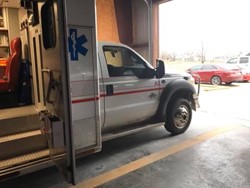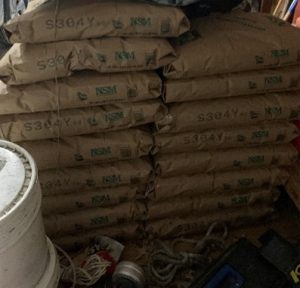By: Steve Repasky
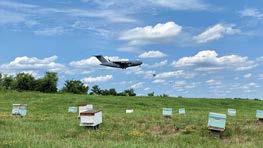
A U.S Air Force C-17 cargo plane approaches a landing over a beeyard at PIT. S. Repasky photo
“Cleared for takeoff” is a common phrase heard at airports all over the world referring to the clearance given by air traffic control to all aircraft wanting to depart the airport. This time though, it refers to the Honey bee Project at Pittsburgh International Airport (PIT) located approximately 15 miles west of downtown Pittsburgh, PA.
Honey bee swarms had more than likely always been present at PIT, but they weren’t monitored and probably weren’t seen as a threat to the safety of the employees and passengers. That all changed in 2012, when PIT had honey bee swarms show up in various locations around airport property, including around the terminals. That August, a late season swarm of honey bees landed on the wing of a Delta CRJ aircraft parked on the ramp that was preparing to depart PIT for JFK Airport in New York.
It was that event that sparked the idea for today’s Honey bee Project. The timing was fortunate for this swarm in a way, because on duty was PIT’s Wildlife Administrator Ben Shertzer. Ben began his position in 2011 and like many people, he had been aware of some of the issues that honey bees were having, including Colony Collapse Disorder. Not wanting to eliminate the swarm but concerned about the safety of the airport employees and passengers as well as the welfare of the bees, a phone call was made to a local beekeeper. I was that beekeeper and took that call. A short time later I arrived at the airport and was escorted by Ben to the awaiting plane and swarm. There on the right wing was a cluster of honey bees and above them, faces of passengers peered through the plane’s windows. The pilots and luggage handlers gathered around but stood at a distance – the societal fear of stinging insects was no doubt intact! Due to the presence of jet fuel, I couldn’t light a smoker, so the decision was made to gently scoop some bees into a cardboard nuc box and let the others walk in. After a short 60-minute delay, the passengers and the bees were on the way to their respective destinations.
The following day, a local TV station picked up on the news of this swarm and wanted to do a story on it. I was heading out of town with a group of beekeepers for a weekend with Dr. Larry Connor but managed to meet up with the reporter to sit for an interview. We talked about how rare and interesting it was to capture a swarm on a plane. Twenty-four hours later, as we gathered for breakfast at Larry Connor’s homestead in Kalamazoo, MI, a local news station was on TV and at the bottom in the scrolling ticker was the headline “Bees Delay Delta Flight at Pittsburgh International Airport”. The story of this now famous swarm continued to flow in and 24 hours later, the story was picked up by the Associated Press, NBC, ABC, CNN the New York Post as well as several aviation news outlets. It also drew attention in the U.K, numerous European countries, Japan and Australia.
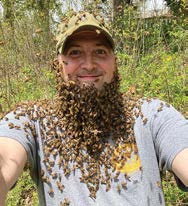
Steve Repasky
The relationship between PIT, with Ben as Wildlife Administrator and myself as beekeeper continued to grow in 2013 as additional swarms appeared on the airfield and I was called to remove and relocate them. As beekeepers, we are always looking for new places to place beehives, so in conversation during each time Ben and I were dispatched to relocate a swarm, he and I would talk about bees and beekeeping and some of the great locations that the airport was likely hiding that could house a beeyard. We also discussed how bees were gentle but there was a concern for airport personnel and how it may or may not affect airport operations. Even as I caught and relocated swarms, Ben and other employees would step away or not get out of the truck in fear of these stinging insects. It was comical in some ways, yet I understood the fear. I would even approach and capture swarms without protective gear just to show that honey bees were fairly docile while in swarm mode. By 2014, Ben’s fear of honey bees had dispersed but the swarms continued to show up and his interest in bees and beekeeping grew.
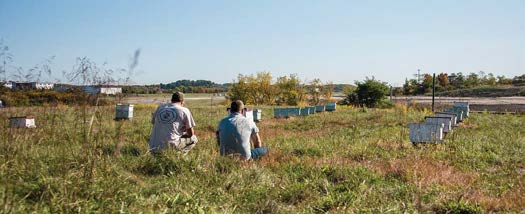
Steve Repasky and Ben Shertzer looking over a beeyard at Pittsburgh International Airport (PIT). Beth Hollerich/Pittsburgh International Airport, photo
Pittsburgh International is an ideal location for honey bees. Comprising of 8,800 acres in total, of which 2,000 acres encompasses the Air Operations Area (AOA) and is off limits. The remaining 6,800 acres is a mosaic of stream bottoms, wetlands, fields and woodlots – remnants of the rural farms that were in the area prior to the development of the airport in the late 1940s. These “undeveloped areas” provided the potential for a variety of blooms from early March through October.
Of course, there are rules to follow in order to get approvals from the appropriate people in order to do something that is rather new. The Allegheny County Airport Authority operates PIT and keeping bees at this airport was new. We were aware of a couple of other airports that had some hives on property but it wasn’t a common practice. We wanted to be sure that we addressed a number of things. How many hives, environmental conditions (forage availability), how the hives would be managed, operational issues as far as access, security and liability would all play a role in the success of this project.

A swarm lands on a directional sign just off a runway at PIT. Ben Shertzer/Pittsburgh International Airport, photo
Several locations for an apiary were identified and vetted for access, forage and the possibility that a chosen site may already be earmarked for airport development and expansion. Besides being a passenger-focused airport, PIT is also home of the Pittsburgh Air Reserve Station and the Air National Guard as well as air cargo facilities. In addition to the previous categories, Ben and I also assessed each potential site for possible conflicts as they may relate to the airport’s Wildlife Hazard Management Plan (WHMP). The FAA requires each airport to maintain a safe operating environment for its employees and all aircraft operations via the use of Wildlife Hazard Assessments and the WHMP.
Over the course of the winter of 2014/2015, our first proposal to airport officials didn’t go anywhere and was rejected. The following year, in early 2016, we pitched to new CEO Christina Cassotis. Christina had taken over as the new CEO of PIT in 2015 and as it turned out, her grandfather had been a beekeeper. A new set of meetings was set up and this time our proposal was met with open arms and a level of excitement we had not seen previously. This project was unique. It would technically be overseen by the Wildlife Administrator, but managed by me as the beekeeper, a non-airport employee. In August of 2016, the first set of 10 hives was placed at a location just one mile south of the airfield.
Over the next couple of years, another four more locations were set up and swarms continued to show up in the AOA. In order to assess ways that the project can be of greater benefit to the airport, we also initiated an extensive and strategic swarm capture program. This program is simple. Swarm traps were hung at ¼ mile increments along the western and southern edge of the AOA beginning in April and were monitored on a weekly basis. This area was chosen due to the “rural-ness” of the property with woods, fields and stream bottoms. The north and eastern side of the airport abuts industrial and urban landscape. The trapping program began in 2019 and it was clear from our data that the trapping program was having an impact on how honey bees affected air operations. From 2012-2016, PIT averaged approximately 15 swarms a year on the AOA. Honey bee colonies were placed on the property in the late Summer of 2016. Between 2017 and 2018, an average of five swarms made it into the AOA and additional beeyards were installed in the following years. In 2020, only three swarms made it into the AOA. The swarm traps placed around the perimeter were working and keeping bees away from sensitive areas. With the collaboration of airport officials and myself as a beekeeper, we are able to show decreased disruption. In addition, a once cautious Wildlife Administrator was trained and was confidently responding to swarm calls to identify and assess location and needs prior to my arrival.
As honey was beginning to be produced on site, many airport employees began asking about it and soon enough, we had a list of people purchasing honey that was produced right where they worked. Some were shocked to hear that there were honey bees at the airport; some were intrigued but they all loved the idea and the taste of the locally produced honey. The once rural landscape turned airport proved to be valuable to the honey bees. As part of the airport’s habitat management, no pesticides are used and mowing is kept to a minimum as part of their WHMP. Because of this, there is always something in bloom.
By the time 2020 rolled around, the Honey bee Project, as it became known to all at the airport, had grown to nine beeyards with approximately 110 colonies. Names for each bee yard were assigned for easy identification. There are some yards that are used solely for honey production. Other yards are used for queen production where some of the queens used in the PA Queen Bee Improvement Project are mated and assessed. Another yard is used to house swarms that are caught to assess for health and viability. The popularity of the project continued to gain momentum. One of the goals for PIT, that CEO Cassotis has pushed for and presented, was to think outside of the box when it comes to ideas for land use at PIT. Her message has always been that the Pittsburgh Airport is more than just an airport. There are uses for the airport and its property in ways people don’t envision and the Honey bee Project is just one of those uses. It garnered the attention of United States Congressman Conor Lamb when he recognized PIT as a cornerstone of economic development during one of his visits to PIT. Congressman Lamb and former PA Senator Pam Iovino toured the apiaries at the airport and acknowledged their benefit to not only the environment but the local economy as well – “it’s a really good example of how [PIT] is thinking out of the box” said Congressman Lamb of the bee project.
The accolades continued as PA Governor Tom Wolf and the Pennsylvania Department of Environmental Protection recognized the Honey bee Project with Governor’s Award for Environmental Excellence in 2020 for its continued efforts toward environmental stewardship. Pittsburgh International is always looking to find innovative solutions and this project not only enhances the safety and efficiency of their operations but it also supports key environmental initiatives.
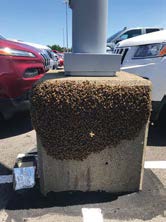
A swarm lands on a directional sign just off a runway at PIT. Ben Shertzer/Pittsburgh International Airport, photo
The Honey bee Project has grown to be something more than we had ever envisioned. The success of the project has led to collaboration with the Airport Cooperative Research Program (ACRP), which is designed to develop practical solutions to problems faced by airport operators. PIT is one of a handful of airports across the United States that has honey bee colonies located on property. A few other airports that have honey bees include Seattle-Tacoma, Portland, Chicago O’Hare, and St. Louis.
As we move forward into 2021, the Honey bee Project at Pittsburgh International Airport will continue to grow. Honey produced will be offered for sale at locations inside the terminals to travelers coming and going to locations around the world, carrying with them honey that was proudly produced at Pittsburgh International. Continuance of the queen improvement program, swarm capture program and the production of honey, pollen and other products of the hive will also continue to move forward. Our hope is to continue to educate employees and the general public about honey bees and how beekeepers and airports can work together. PIT is among the first U.S airports to have a beekeeping program and there aren’t many with beekeeping programs of this size and scope. It continues to support Pittsburgh International Airport’s commitment to preserving the environment and supporting conservation and sustainability efforts.
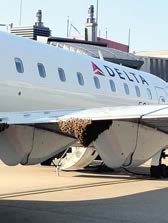
Swarm on the Delta jet bound for JFK. The swarm that started it all. S. Repasky photo
A big “thank you” to the management and employees at PIT for opening up their arms to this project. The enthusiasm continues to grow as more people become aware of the many non-aviation activities that take place there. A special note of thanks to Ben Shertzer, Wildlife Administrator, for taking this project on and supporting it all the way to the top. This project benefits greatly from his support both administratively and physically when it comes to obtaining authorizations or checking swarm traps and relocating swarms.
Stephen Repasky is an author, lecturer, consultant and EAS Certified Master Beekeeper from Pittsburgh, PA. He is the owner of Meadow Sweet Apiaries and is the author of the book Swarm Essentials. In addition to his own beekeeping operation, he can be found managing the bees at PIT and speaking to numerous clubs and conferences across the United States.







